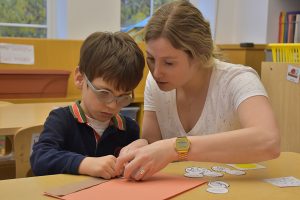by Donna Logue, Director of Lower Division
 If you are like me, you were surprised when you first heard someone describe Gaynor’s approach to curriculum design as “diagnostic-prescriptive.” It seems like an unusually clinical term for a school that prides itself on providing a nurturing, child-focused educational environment. Yet, I soon discovered when I began working at Gaynor in 1999 that the term very accurately conveys how we create individualized programs for each of our students. In fact, when I asked Co-Founder Yvette Siegel-Herzog about the origins of Gaynor’s diagnostic-prescriptive approach in preparation for writing this article, she said just that. She explained that when the term first began to appear in the literature in the 1970s, she quickly adopted it because it so aptly captured her underlying philosophy of education.
If you are like me, you were surprised when you first heard someone describe Gaynor’s approach to curriculum design as “diagnostic-prescriptive.” It seems like an unusually clinical term for a school that prides itself on providing a nurturing, child-focused educational environment. Yet, I soon discovered when I began working at Gaynor in 1999 that the term very accurately conveys how we create individualized programs for each of our students. In fact, when I asked Co-Founder Yvette Siegel-Herzog about the origins of Gaynor’s diagnostic-prescriptive approach in preparation for writing this article, she said just that. She explained that when the term first began to appear in the literature in the 1970s, she quickly adopted it because it so aptly captured her underlying philosophy of education.
Using a diagnostic-prescriptive approach, as the name connotes, entails analysis on two levels. The first, the diagnostic, involves the development of a comprehensive understanding of a student’s strengths and abilities, affinities, areas of struggle and vulnerabilities. While we do use information from formal tests, including neuropsychological evaluations, we take a very broad approach to creating a portrait of each individual student as a learner. Most important at Gaynor is frequent observation of students in their daily school lives and analysis of regular student work by all members of the educational team – teachers, therapists, specialists and administrators.
“That’s the assessment I valued and I do to this day,” maintains Siegel-Herzog, “rather than testing.” Each educational team is constantly using authentic assessments to begin to answer critical questions, in both a global sense — When is this child invested in learning? When are they most successful? What is challenging for this child now? Where is the child making progress? — and with respect to specific aspects of curriculum — Why is this student struggling with subtraction? What aspects of essay writing are challenging for this student? Is this student more successful if there is less information on the page? Does modifying the language demands of an activity make it easier for the student to show what they know?
The second part, the prescriptive, uses the profile developed in the diagnostic phase to create a plan for remediating areas of struggle and ensuring that students are appropriately challenged. It, too, works on the macro and micro levels. As a divisional director, my first task each school year is to use each student’s learning profile to determine class placement. To build classes, I ask questions, such as: Who would be the best teacher for this child at this developmental stage? Which peers would motivate this child to be their best self? On the daily level, the teaching team and I use trial and error to find materials to which the student responds and strategies that work for them. We may use a well-established methodology (such as Orton-Gillingham, Singapore Math, or Multi-Paragraph Outlines) or create something new (such as LEGO Batman math fact flashcards or a custom color-coded editing checklist), but each time we try an intervention, we step back and evaluate whether it is truly moving the student forward. If it is, we continue to build on that success. If it is not, we go back, reassess, and then try something else.
If we are dedicated to teaching individual students, then we must understand who they are. Using a diagnostic-prescriptive approach enables the educators at Gaynor to remain focused on unwrapping each student’s full self and providing them with curriculum tailored to truly unlock their potential by making learning meaningful for them.
